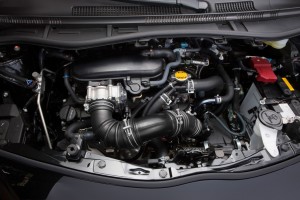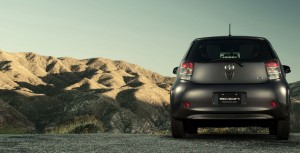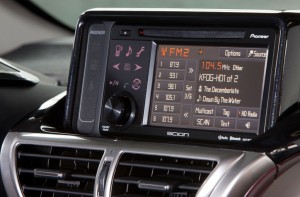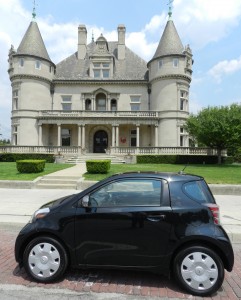
Scion's little iQ is great for bopping around city centers in areas such as the Wayne State University campus in Detroit.
A thought came to mind while coming back from a meeting in downtown Detroit: At least this Scion iQ is better than a Smart ForTwo.
Admittedly, it’s a low bar. In a way, it’s unfair to review these little midget cars on our wide-open American roads. But if the automakers continue pitching them, we’ll keep reviewing ‘em.
At a tick over 120 inches, iQ is actually 14.5 inches longer than the Smart. With that extra length, Scion gave the iQ a tiny back seat, allowing it to claim that the iQ is the world’s smallest four-seater. Eh, OK, sure there four seats in there with four seatbelts, but, fit four actual people back there? Well, more on that later.
We spent a little time running around the Wayne State University campus in the iQ. This would seem to be the perfect habitat for a micro like the iQ. It was nice being able to spin the steering wheel for a quick u-turn – the iQ would seem to have the turning radius of a zero-radius turn lawnmower – and the little car will fit in virtually anything resembling a parking spot.
With their crowded city centers, micros like the iQ make sense in Japan and Europe. But in America, the cities are generally separated by wide expanses of green and connected by smooth ribbons of asphalt. That’s a habitat where the iQ does not excel.
The little Scion is powered by a 1.3-liter 94-horsepower four cylinder that sends its power to the front wheels via a continuously variable transmission – the only transmission available. That isn’t a lot of power, but then again, the iQ doesn’t weigh very much.
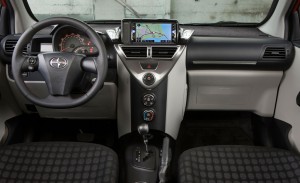
The right side of the iQ's dash is scooped out, allowing the passenger seat to slide far enough forward for someone to sit in back.
Acceleration is tepid. It’s far better than the ForTwo, which has just 70 horsepower, but there aren’t many other cars that it will beat in a stoplight drag race.
As is the norm with CVTs, the one in the iQ causes the engine to drone, even if it is calibrated to allow the engine to rev as it “shifts” gears. Automakers use CVTs because they tend to provide better fuel economy than a traditional geared transmission, but that doesn’t make them any less annoying.
The interior is well finished, but there’s no getting around how small it is. The front seats sit high, so high that this driver ended up looking straight at the trailing edge of the sun visor. A control to lower the seat would help. The dash design is extremely simple, but the controls for the trip odometer are hard to reach.
The radio sits high on top of the center console, in a sort of floating piece that looks a bit like a B-2 Stealth bomber flying above the dash.
Now about that seating for four. At 5-foot-10 and the seat set for me, there was literally an inch between the rear seat cushion on the front seat. Anyone sitting behind a normal-size driver better have no legs.
It’s a different story on the passenger side. The dash on the right side of the car is carved out, so the front-seat passenger can comfortably slide his seat forward, providing enough room for a smallish person to sit in back. Unfortunately, hard cupholders press uncomfortably into the thighs of rear-seat passengers. The formless rear bench has grippy fabric, but not much in the way of any shape. No matter, even if the driver is feeling frisky, rear-seat passengers won’t be sliding because there’s nowhere to go anyway.
So it’s better to think of the iQ as a two-and-a-half seater or three-seater.
Not surprisingly, cargo space is miniscule. Scion claims 3.5 cubic feet with the rear seats up, but the space is so slim, the only thing that will fit would be a lightly packed soft briefcase. Cargo space expands to a still paltry 16.8 cubes with the rear seats folded.
Styling is a strong suit. The pugnacious little squirt has nice details.
The car handles well enough on local roads. Not surprisingly, the steering is go-kart quick. The ride is acceptable; about as good as one could expect from a car with a wheelbase of less than 79 inches. On the freeway, the car tends to feel a little nervous, as if one of the semis in the next lane were thinking about eating it for lunch.
Since price is the first consideration for most car buyers, especially those shopping in the teens, it’s worth looking at what else you might be able to afford.
For less than 17 grand, you could buy a Ford Fiesta with an automatic transmission with enough money left over to upgrade to a stereo with a CD player, although you wouldn’t get the Sync infotainment control system.
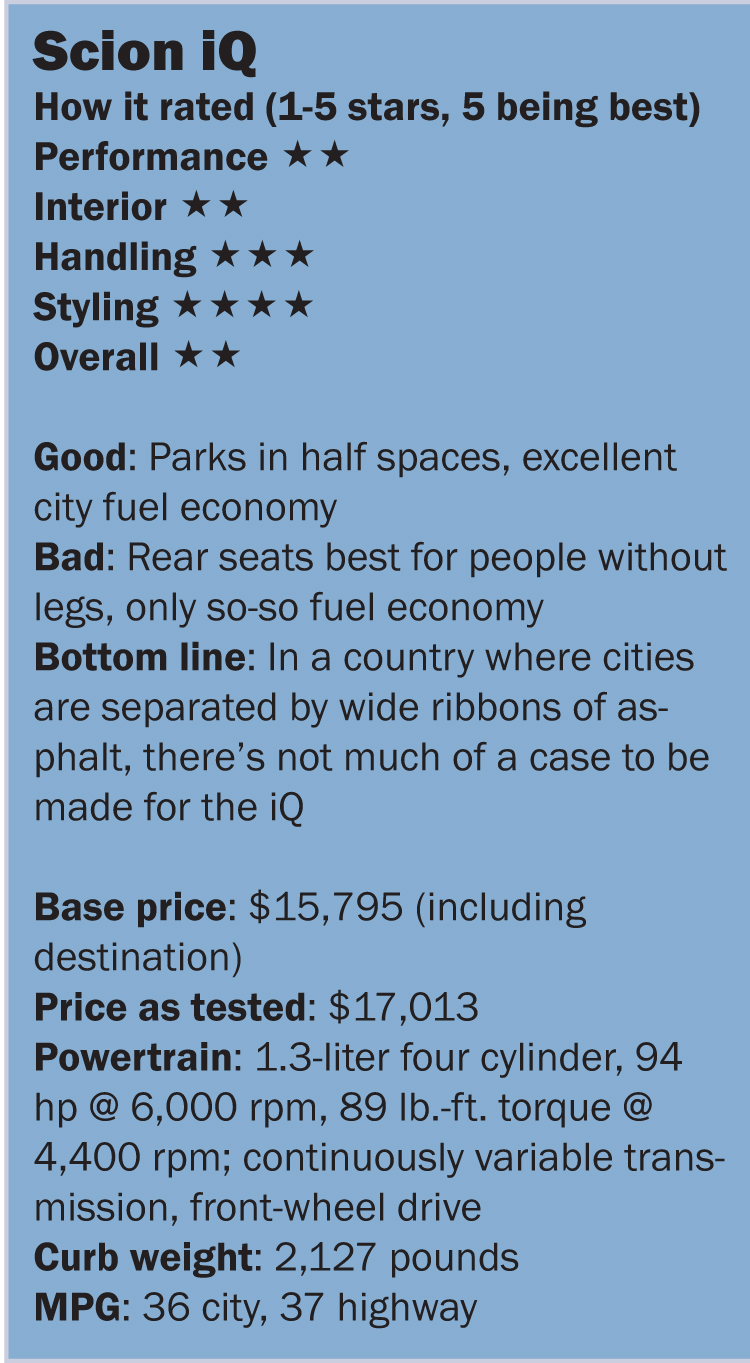 So what’s the reason to buy? Fuel mileage? Compared to the Fiesta, the iQ is significantly better in the city: 36 vs. 29, but not as good on the freeway (39 vs. 37). So, if you spend a lot of time tooling around the city, the iQ would have an advantage, so long as your plans don’t involve transporting more than one and a half friends.
So what’s the reason to buy? Fuel mileage? Compared to the Fiesta, the iQ is significantly better in the city: 36 vs. 29, but not as good on the freeway (39 vs. 37). So, if you spend a lot of time tooling around the city, the iQ would have an advantage, so long as your plans don’t involve transporting more than one and a half friends.
It’s interesting that a 2,100 pound car with a Lilliputian engine wouldn’t get better fuel mileage. The reason is aerodynamics. These little cars are tallish, have more upright windshields and are so short, they don’t do a very good job conditioning the air as it travels over the back end.
And the Fiesta is just one option. The Honda Fit, Toyota Yaris and Chevrolet Sonic could all make similar cases. In fact, some of those automakers’ compacts – essentially two sizes up from the iQ – would also be available in that price range and still get better freeway mileage.
Since the price of our Fiesta is virtually identical to the iQ, a lower payment won’t justify the smaller car’s purchase.
The iQ starts at $15,795, including destination. Add an iPod-ready Pioneer HD radio with CD player ($479) and XM satellite radio (a lofty $449) and carpeted floor mats ($90) for a total of $17,013.
If parking is a problem, the iQ has something to offer.
But beyond parking, it would seem that there are a host of better choices on the market.

